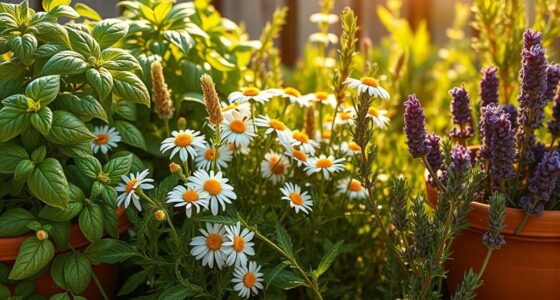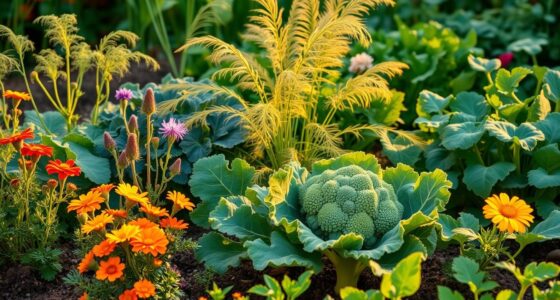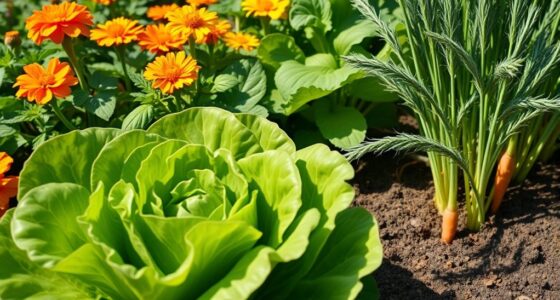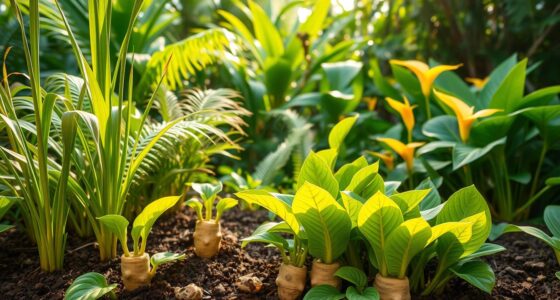To boost your potato crop naturally, plant beans or legumes nearby to fix nitrogen and improve soil health. Marigolds and other pest-repelling flowers can help deter aphids, beetles, and nematodes while attracting beneficial insects. Incorporate herbs like basil, mint, or chives to enhance growth and ward off pests. Adding horseradish can also deter pests and improve soil conditions. Keep exploring these companion choices to make your garden more productive and pest-resistant.
Key Takeaways
- Plant marigolds and nasturtiums near potatoes to repel pests like nematodes and aphids naturally.
- Grow beans and legumes alongside potatoes to fix nitrogen and improve soil health.
- Include herbs such as basil and chives to boost growth and deter fungal and insect pests.
- Use horseradish as a natural pest repellent and soil enhancer around potato beds.
- Incorporate pest-repelling flowers like petunias to attract beneficial insects and reduce pest issues.
Tomatoes and Other Nightshades

Tomatoes and other nightshades can be excellent companions for potatoes because they share similar growing requirements and can help maximize space in your garden. Both thrive in well-drained, nutrient-rich soil with full sun exposure. Planting them nearby allows you to optimize your garden layout efficiently. Nightshades also benefit from similar watering schedules, reducing complexity in maintenance. However, keep in mind that both are susceptible to some common pests, like aphids and blight, so regular monitoring is essential. Growing tomatoes and potatoes together can also improve airflow around plants, which helps prevent disease. Additionally, their different root structures can minimize competition for nutrients, making this pairing a practical choice for gardeners looking to boost yield without overcrowding.
Beans and Legumes
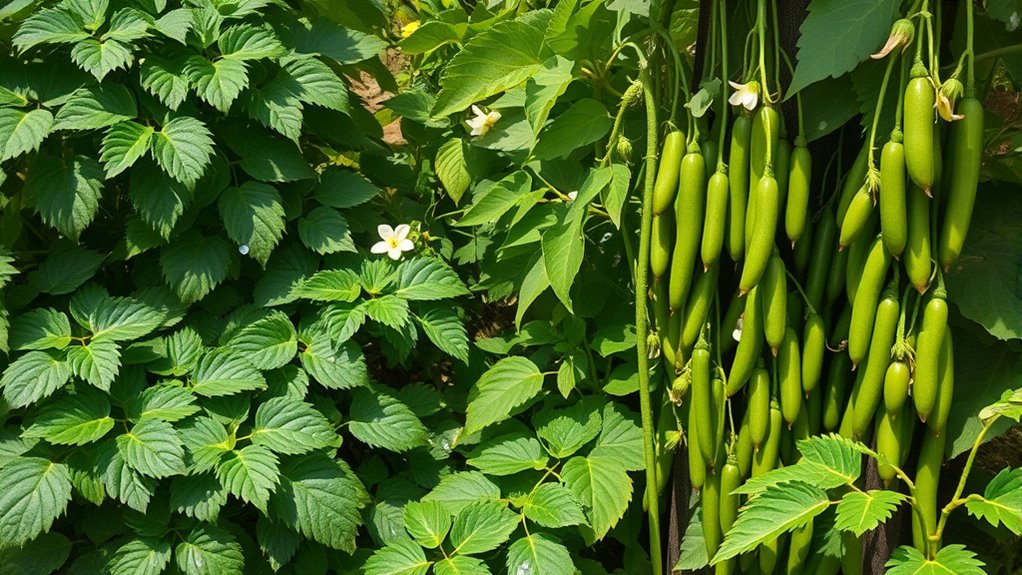
Beans and legumes make excellent companions for potatoes because they enrich the soil with nitrogen through their natural fixation process. This benefits your potatoes by providing essential nutrients, reducing the need for fertilizer. Growing beans nearby can improve soil health and boost your harvest’s quality. Additionally, their vining habit can help shade the soil, keeping it moist and reducing weed growth. Here are three benefits of planting beans and legumes with potatoes:
Plant beans near potatoes to boost soil health, reduce weeds, and enhance harvest quality naturally.
- Natural nitrogen fixation enhances soil fertility.
- Vines protect soil from erosion and weeds.
- They attract beneficial insects that help control pests.
Furthermore, selecting the right projector technology can improve your gardening experience by providing better visual guidance and planning tools.
Incorporate beans or legumes into your garden to create a sustainable, productive environment for your potatoes, maximizing growth and health without extra effort.
Marigolds and Other Pest-Repelling Flowers
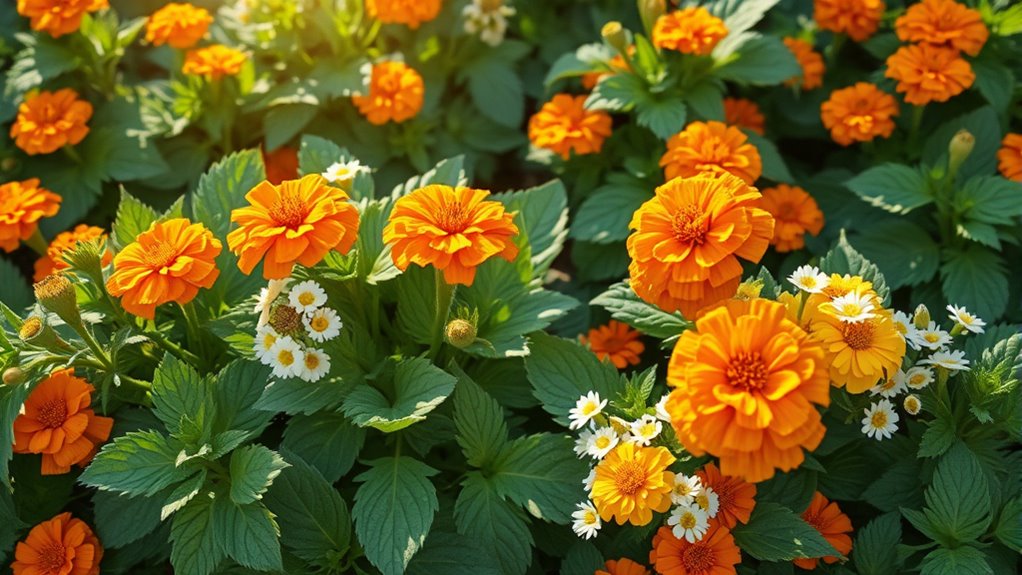
Planting marigolds and other pest-repelling flowers near your potatoes can considerably reduce pest problems by deterring insects before they reach your crop. Marigolds emit strong scents that repel nematodes, aphids, and beetles, protecting your plants naturally. Other flowers like calendula, nasturtiums, and petunias also help keep pests at bay while attracting beneficial insects such as pollinators and predatory bugs that feed on harmful pests. These companion plants create a natural barrier, reducing your reliance on chemical pesticides. Additionally, pest-repelling flowers add visual appeal and attract pollinators, which boost overall plant health. To maximize their benefits, plant these flowers around the perimeter of your potato patch or intersperse them among your potatoes. Incorporating companion planting techniques can further enhance pest control and crop productivity. Understanding the ecological benefits of these flowers can help you develop a more sustainable gardening approach. Using natural pest deterrents like pest-repelling flowers contributes to a healthier garden ecosystem. This simple strategy can lead to healthier, more vigorous potato plants.
Horseradish and Its Benefits

Horseradish is a powerful companion plant for potatoes because it helps deter pests and improve soil health. Its strong aroma confuses and repels harmful insects, reducing the chances of infestations. Additionally, horseradish enhances soil quality by breaking up compacted soil and increasing microbial activity, which benefits potato growth. When you plant horseradish near your potatoes, you create a natural pest barrier and boost plant vigor. Here are three benefits to contemplate:
Horseradish deters pests, improves soil, and promotes healthier potato growth naturally.
- Pest deterrence, especially for root maggots and beetles
- Soil aeration and increased microbial activity
- Natural disease suppression, promoting healthier potatoes
Planting horseradish strategically offers a simple, effective way to support your potato crop naturally. A beneficial relationship exists between horseradish and soil health that can further enhance crop yields. Incorporating horseradish into your garden not only helps with pest control but also fosters a healthier soil ecosystem, which is crucial for sustainable gardening. Additionally, horseradish can help disrupt the life cycle of pests, making it a valuable integrated pest management tool.
Furthermore, understanding the soil microbial activity can help gardeners maximize the benefits of planting horseradish alongside potatoes.
Herbs That Promote Growth and Deterrence
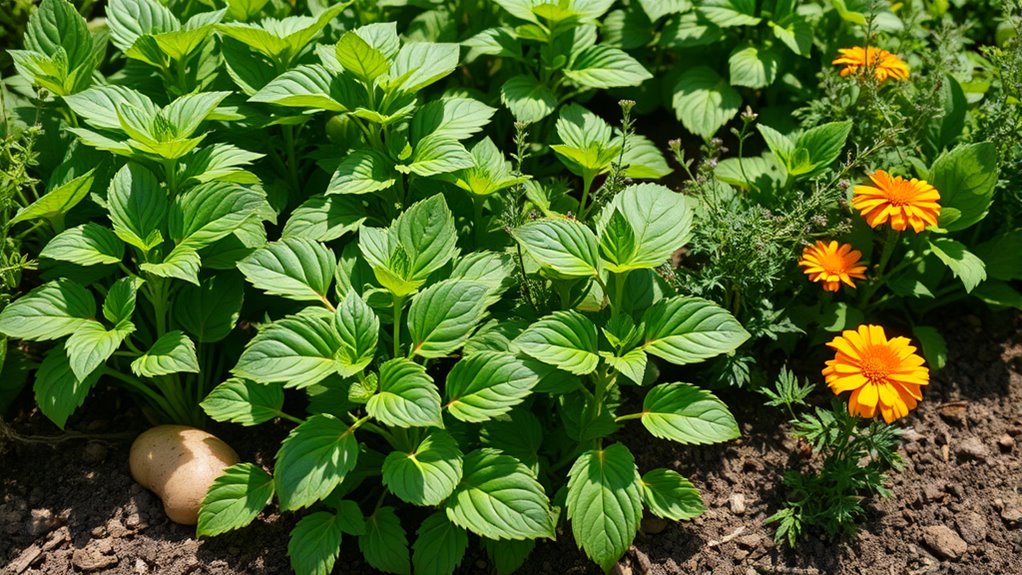
Herbs can be powerful allies in your potato garden, providing both growth promotion and natural pest deterrence. Basil, for example, repels insects like aphids and beetles while encouraging healthy growth. Mint deters pests such as flea beetles and attracts beneficial insects that prey on pests. Chives help prevent fungal diseases and improve overall plant vigor. Incorporating these herbs strategically can enhance your potato yield and reduce the need for chemical interventions. Here’s a quick overview:
| Herb | Benefits | Pest Deterrence |
|---|---|---|
| Basil | Boosts growth, repels insects | Aphids, beetles |
| Mint | Deters pests, attracts beneficial insects | Flea beetles |
| Chives | Prevents fungal diseases | Aphids, some beetles |
Using companion planting techniques can also improve garden health and increase resilience against pests and diseases. Use these herbs to strengthen your potato plants naturally.
Frequently Asked Questions
Can I Plant Companion Plants With Potatoes in Containers?
Yes, you can plant companion plants with potatoes in containers. Just make sure the plants have compatible space and light needs. Herbs like basil or dill work well, and they can help repel pests. Avoid overcrowding by choosing plants that won’t compete for nutrients or space. With proper planning, your container garden can thrive, giving you healthy potatoes alongside beneficial companions for a more productive and pest-resistant setup.
Do Companion Plants Affect Potato Harvest Size?
You might wonder if companion plants influence your potato harvest size. They can, in fact, help improve yield by reducing pests, improving soil health, and providing shade. When you plant the right companions, they support your potatoes’ growth, which can lead to larger, healthier tubers. However, avoid plants that compete for nutrients or space. Properly chosen companions can be a great boost to your potato harvest.
Are There Any Plants to Avoid Near Potatoes?
Like the forbidden fruit in the Garden of Eden, some plants are best kept away from your potatoes. Avoid planting tomatoes, peppers, and fennel nearby, as they can hinder growth or attract pests. Also, steer clear of planting potatoes near other nightshades or crops prone to similar diseases. Keeping these plants apart helps your potatoes thrive, ensuring a healthy, bountiful harvest without inviting trouble.
How Often Should I Rotate Companion Plants With Potatoes?
You should rotate your companion plants with potatoes every planting season or at least once a year. This practice helps prevent soil depletion, reduces pest buildup, and minimizes disease risks. By changing the plants around your potatoes, you create a healthier environment, encouraging better growth. Keep track of your rotations to make sure each plant benefits from fresh soil and avoids the problems caused by growing in the same spot repeatedly.
Do Companion Plants Help Prevent Potato Blight?
Did you know that nearly 20% of potato crops are lost annually to blight? Companion plants can help prevent potato blight by promoting airflow, reducing humidity, and deterring the spread of fungal spores. By planting things like beans or horseradish nearby, you create a less hospitable environment for the disease. So, yes, choosing the right companions can be an effective natural way to protect your potatoes from blight.
Conclusion
By planting these companions, you’ll boost your potato harvest and naturally deter pests. Did you know that marigolds can reduce nematodes by up to 80%? Incorporating tomatoes, beans, marigolds, horseradish, and herbs into your garden not only improves growth but also creates a healthier, more resilient environment. So, next time you plant potatoes, consider these allies—they’ll help you grow a more productive and pest-resistant garden effortlessly.


